How will increasingly frequent hot weather affect infectious diseases? There’s good news and bad news here.
The good news: 63 infectious diseases could be reduced as a result.
The bad news: 218 infectious diseases became more prevalent as a result.
And how many infectious diseases are known to humans? 375 species. In other words, human beings not only have to face hotter and hotter summers, but also face the clarion call of more than half of infectious diseases [1].

Satellite image of Poyang Lake in August 2022. Click on the picture to view the satellite picture of Poyang Lake in August 2021 | Symbiosis Earth Remote Sensing Laboratory
Hot weather,
is a favorite of certain infectious diseases
The notorious Bacillus anthracis, which is used as a biochemical weapon, is a pathogenic bacteria that exists in the soil. In addition to humans, it can also spread among wild animals, especially herbivores. In 2016, there was an outbreak of anthrax in the Yamal Peninsula of Russia, 75 years after the last anthrax outbreak in the region.
The reason is that the hot and dry summer of that year melted part of the permafrost in the local area. From June to August 2016, the average monthly temperature of this place was 20-100% higher than that of the previous 30 years, and the maximum temperature was 16-75% higher. The rising temperature has brought the anthrax bacillus buried deep underground to light. In the end, the Grim Reaper, who traveled through 75 years, harvested the lives of more than 2,000 reindeer, resulting in the hospitalization of 90 local residents and the death of 1 child [2].

The permafrost looks calm, but it is actually extremely dangerous丨Tasnim News Agency / CC BY 4.0(https://creativecommons.org/licenses/by/4.0/)
The Yamal Peninsula has at least a history of anthrax outbreaks in history, and there are traces to follow. But after the disease embraces the thighs of hot weather, more can be done.
Many infectious diseases require vectors, such as bats, mosquitoes, mice and so on. Rising temperatures can help vector animals survive the winter, expand the geographic range of vectors, and expand the distribution of already existing diseases. Infectious diseases, including malaria, African trypanosomiasis, Lyme disease, tick-borne encephalitis, yellow fever, plague, and dengue fever, have all expanded in response to rising global temperatures [1].
Of course, there are also a small number of pathogens that will affect their own metabolism due to high temperature, and eventually become less, and some pathogens are not affected by temperature. So they can’t borrow the east wind from the hot weather? Of course not, they can use natural disasters caused by high temperature weather to expand their spread.
Hot weather,
Also a favorite of Scourge
How do rising temperatures affect natural disasters? Let’s do a little thought experiment first. Picture in your mind how high temperatures would affect drylands, wetlands, and oceans. As a tip, think about the effect of air temperature on water.
Click on the space below to get the answer
In arid regions, high temperatures accelerate the evaporation of water from the land. Ultimately, extremely dry land cannot rely on evaporation to cool itself, contributing to ever-rising temperatures. As a result, heat waves struck and wildfires broke out frequently.
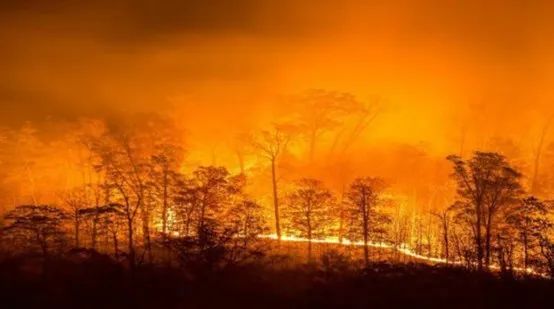
Mountain Fire丨factly.in / CC BY 4.0 (https://ift.tt/Jmo4KwM)
In humid areas, the moisture in the soil cannot be evaporated. As a result, the high temperature pumped a large amount of water into the sky, which turned into torrential rain and returned to the earth. The instant travel of water molecules has obviously caught up with the golden week of tourism. In the end, you will most likely see the congested water in this journey- flood .
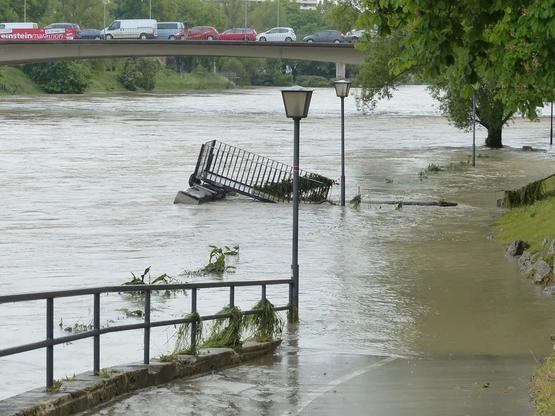
Flood 丨 pixabay
At sea, though, the danger of flooding can be spared. But the swirling and jumping water between heaven and earth will intensify the intensity of storms and rainfall. This undoubtedly increases the difficulty of driving aircraft and ships. The sea level raised by the melting of glaciers and the intensified storm will cause damage to the coastal area [1].
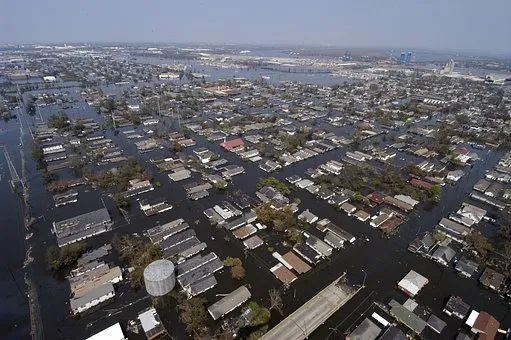
The city after the hurricane 丨 pixabay
Our good neighbor Batie paid for this year’s extremely hot weather.
Pakistan is adjacent to the Indian Ocean in the south, and the rainy season is from July to September every year, with a humid climate; the lower reaches of the Indus River running through Pakistan are located in plains with low terrain. All these paved the way for the arrival of the great flood. This year’s hot weather has made the Indian Ocean more water vapor than in previous years, which undoubtedly became the last straw that broke the camel’s back. The flood not only directly killed more than 1,700 people and injured more than 12,000 people, but also caused the death of more than one million domestic animals, and damaged more than 10 million meters of roads and more than two million houses and bridges [3].
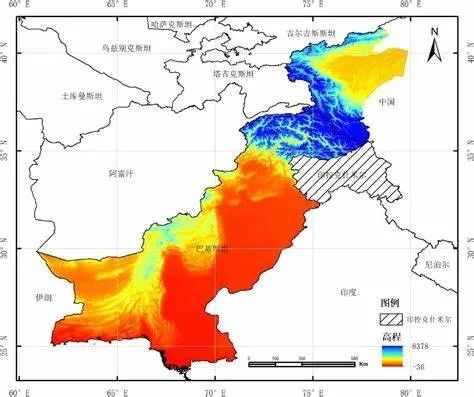
Pakistan’s topography, the warmer the tone, the lower the terrain丨National Glacial and Permafrost Desert Scientific Data Center (http://www.ncdc.ac.cn)
Even if you are lucky enough to survive, it does not mean you have escaped death. The floods nearly destroyed the already fragile public health system: about one-tenth of the sanitation facilities were destroyed, leaving millions of people without access to basic medical services. Essential medicines and medical supplies were either washed away by the floods or were in limited quantities. Roads and bridges damaged by the floods have prevented aid personnel and supplies from reaching the affected areas, and disease surveillance and referral mechanisms have also been severely disrupted[4].
Before the flood arrived, infectious diseases such as new coronary pneumonia, polio, and measles were already raging in Pakistan itself. The arrival of the floods directly hindered vaccination efforts for these diseases. On the other hand, floods are accompanied by mosquito breeding, allowing water-borne and insect-borne diseases to flourish. Such as malaria, cholera, dengue fever, acute watery diarrhea and so on. If this flood occurred in ancient times, it may eventually become another evidence of “big disasters followed by serious diseases”.
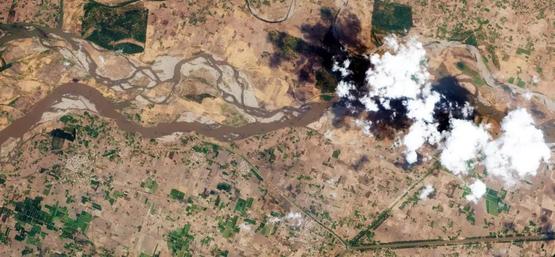
Satellite image of the Chenab River in Punjab, Pakistan (June 4, 2022)丨Symbiont Earth Remote Sensing Laboratory

Satellite image of the Chenab River in Punjab, Pakistan (August 26, 2022)丨Symbiont Earth Remote Sensing Laboratory
In today’s era, diseases such as cholera and measles can be prevented by vaccines, and unpreventable diseases such as malaria can also be cured by drugs. International aid can address the lack of medical care. What remains to be solved is how to deliver medicines and vaccines to those in need during the flood. As mentioned above, the local roads were damaged or submerged by floods, and there are only a handful of intact parts, and the means of transportation have become less reliable. Nizam Uddin is a vaccinator in Sindh Province, the hardest-hit area, and his working location is 70 kilometers away from the urban area. In order to reach the target family and get vaccinated smoothly, he had to be prepared to wade in water at all times. There are more than 2,500 vaccinators like him in the whole Sindh province [5].
But even with international aid and the tireless efforts of local vaccinators, all we can do is slow the pace of the contagion, reduce the death toll, and prevent major outbreaks. From July to September after the flood, the number of newly diagnosed cases of malaria alone in Pakistan exceeded 500,000. In Balochistan, another heavily affected province, the malaria-positive rate was 14.1% in July and 30.7% in September [6]. Diseases hitch a ride on natural disasters, and human beings try their best to resist.
Does disease have nothing to do with us if disasters occur in uninhabited areas? Nor is it. To give a simple example, forest fires, storms, floods, etc. will prompt wild animals to flee in panic, greatly increasing the possibility of contact with humans. These wild animals, which were originally far away from human habitation, are likely to carry some unknown disease, so they are not safe [1].
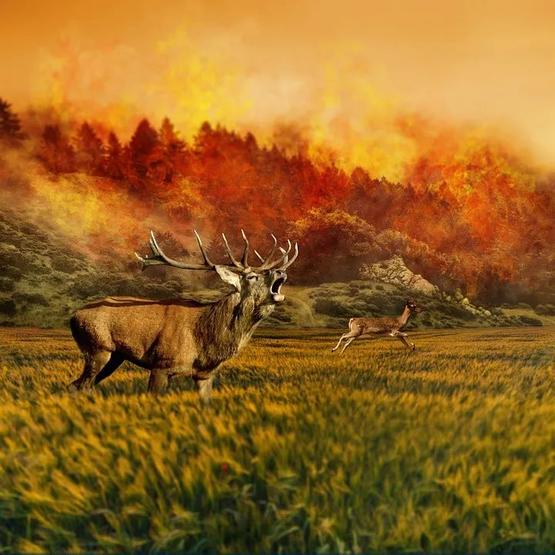
Forest fires, storms, floods, etc. will cause wild animals to flee in panic | pixabay
Heinrich’s law tells us that for every serious accident that causes serious injury or death in industrial production, there will be 29 minor injury accidents behind it, and 300 accidents without casualties. That’s why we have to “prevent problems before they happen” and eliminate every potential safety hazard in peacetime.
The same is true for infectious diseases. Every epidemic that seems to be an independent event is the result of countless unnoticed events interlocking. Every global pandemic of a disease may be followed by dozens of regional epidemics of the disease, hundreds of species of organisms that do not cause disease and close contact with humans. Every storm and every wildfire may be the beginning of a plague. When the epidemic is raging, we must rely on technology, medicine, and everyone’s determination to fight the disease to resist the disease; after the epidemic calms down, we must rely on the spirit of “prevention before it happens” to eliminate every hidden danger that may cause the epidemic.
*Thanks to Symbiosis Earth Remote Sensing Laboratory for the photo
Global Health and Development Guardians Program
We care about every flash of inspiration of scientists, and every step of development and exploration in unknown fields. But this time, we want to focus on the poor around the world.
They live in distress and are more vulnerable to harm: climate change, infectious disease, hunger, poverty, newborn deaths, sexism… What can science and innovation do for them?
The Global Health and Development Guardian Program recruits and trains creators and communicators, promotes the production of various high-quality content, encourages dissemination and voice, so as to spread the concept of concern for global health and global development to the public, and let the poor get more attention. And expect this attention to actually improve their situation.
references
[1]MORA C, MCKENZIE T, GAW IM, et al. Over half of known human pathogenic diseases can be aggravated by climate change [J]. Nature Climate Change, 2022, 12(9): 869-75.
[2]LISKOVA EA, EGOROVA IY, SELYANINOV YO, et al. Reindeer Anthrax in the Russian Arctic, 2016: Climatic Determinants of the Outbreak and Vaccination Effectiveness [J]. Front Vet Sci, 2021, 8: 668420.
[3]AUTHORITY ND M. NDMA Floods (2022) SITREP-2022 (Daily SITPER No 136 Date 27th DCtober, 2022) [R], 2022.
[4]WHO. Speech by WHO Director-General at the Pakistan Emergency Relief Briefing held by the United Nations Office for the Coordination of Humanitarian Affairs on October 4, 2022[R], 2022.
[5] WHO. Selfless heroes battling health emergencies in flood catastrophe [R], 2022.
[6]WHO. Pakistan floods situation report issue #2 – 14 October 2022 [R], 2022.
Author: Jiujiu
Edit: sad baby thallium
Typesetting: Yin Ningliu
Title image source: Pixabay


[Extended reading] In addition to wearing masks, we have to face a hotter and longer summer
This article is transferred from: http://www.guokr.com/article/463103/
This site is only for collection, and the copyright belongs to the original author.